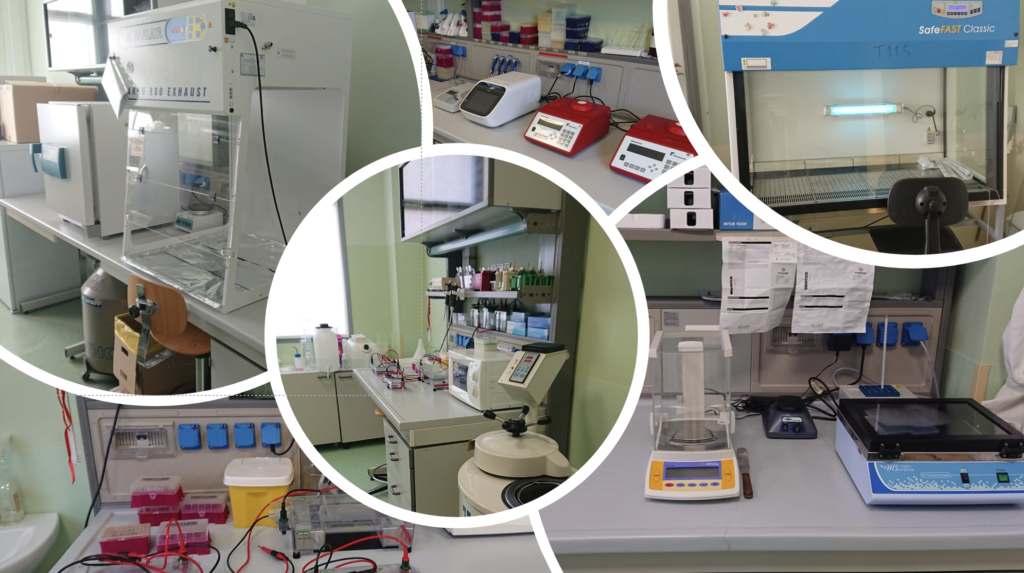Services
Canine Infectious Diseases
- Hemorrhagic gastroenteritis: identification of Carnivore protoparvovirus 1 (formally canine parvovirus, CPV-2a/2b/2c) by PCR using consensus primers for all members of Carnivore protoparvovirus 1 species; virus isolation on cell cultures; identification by indirect immunofluorescence
- Infectious canine hepatitis – Rubarth’s disease: identification of canine adenovirus type 1 (CadV-1) by nested PCR
- Canine distemper: identification of canine distemper virus (CDV) by nested RT-PCR
- Canine monocytic Ehrlichiosis: identification of Ehrlichia canis (E. canis) by nested PCR
- Abortion, stillbirth, vulvovaginitis, balanoposthitis: detection of canine herpesvirus type 1 (CHV-1) by nested PCR
Summary table with guidelines for sending sample to the lab
| Pathogen | Available test | Sample |
| CPV | PCR; isolation | Faeces; dry rectal swab |
| CadV-1 | nested PCR | Faeces; dry rectal swab; EDTA blood |
| CDV | nested RT-PCR | EDTA blood; dry conjunctival/oral swab, urine. |
| E. canis | nested PCR | EDTA blood; lymph node, spleen or medullary aspirate |
| CHV-1 | nested PCR | Dry vaginal/preputial swab; organ from aborted foetus; semen; conjunctival or pharyngeal swab |
- PCR and RT-PCR profile to identify viral enteritis agents Canine viral diarrhea represents the most frequent clinical condition in <12 months old dogs. Historical viral agent involved is canine parvovirus (CPV-2), although it has been proven that many others viral enteropathogens can act alone or synergistically
- Carnivore protoparvovirus 1 (formally canine parvovirus, CPV-2a/2b/2c): PCR using consensus primers for all members of Carnivore protoparvovirus 1 species; virus isolation on cell cultures; identification by indirect immunofluorescence
- Canine coronavirus (CCoV): nested RT-PCR
- Norovirus and sapovirus: RT-PCR using consensus primers for Caliciviridae;
- Canine Kobuvirus (CaKoV): RT-PCR using consensus primers for Kobuvirus;
- Carnivore protoparvovirus 2: real-time PCR and qualitative PCR
Type of sample to send to the laboratory: faeces in special containers with screw cap; dry rectal swab.
- PCR and RT-PCR profile to identify Canine Infectious Respiratory Disease viral agents. Canine Infectious Respiratory Disease (CIRD) commonly called “Kennel cough”, is a multifactorial disease that affect dogs of all ages, caused by viral infections and frequently associated with secondary bacterial infections
- Canine adenovirus type 2 (CadV-2): nested PCR
- Canine herpesvirus canino type 1 (CHV-1): nested PCR;
- Canine distemper virus (CDV): nested RT-PCR
- Carnivore protoparvovirus 2: real-time PCR and qualitative PCR
- Bordetella bronchiseptica (B. bronchiseptica): PCR
Type of sample to send to the laboratory: pharyngeal swab; nasal swab; conjunctival swab (dry swab).
Feline Infectious Diseases
- Feline panleukopenia: identification of Carnivore protoparvovirus 1 (formally panleukopenia virus , FPV) by PCR using consensus primers for all members of Carnivore protoparvovirus 1 species; virus isolation on cell cultures; identification by indirect immunofluorescence
- Feline calicivirosis: identification of feline calicivirus (FCV) by nested RT-PCR and real time RT-PCR; virus isolation.
- Feline viral rinotracheitis: identification of FHV-1 by PCR
- Feline chlamydiosis: detection of Chlamydia felis (C. felis) by PCR with consensus primer for all members of Chlamydia genus
- Suspect of feline infectious peritonitis: detection of FeCoV by RT-PCR, real time RT-PCR, indirect immunofluorescence
Summary table with guidelines for sending sample to the lab
| Pathogen | Available test | Sample |
| FPV | PCR; isolation | Faeces; dry rectal swab |
| FCV | nested RT-PCR; real time RT-PCR; viral isolation | Pharyngeal swab and conjunctival swab (dry); it requires to send also a rectal swab and EDTA blood are also required if other clinical signs are present in addition to respiratory ones |
| FHV-1 | PCR | Conjunctival and fharyngeal swab (dry) |
| C. felis | PCR e restriction digest | Conjunctival and fharyngeal swab (dry) |
| Suspect of feline infectious peritonitis | RT-PCR; real time RT-PCR; indirect immunofluorescence | Abdominal and/or thoracic effusion; biopsies; EDTA blood; dry rectal swab. |
PCR and RT-PCR tools to identify viral enteritis agent
- Carnivore protoparvovirus 1 (formally feline parvovirus (FPV); canine parvovirus , CPV-2a/2b/2c): PCR using consensus primers for all members of Carnivore protoparvovirus 1 species; virus isolation on cell cultures; identification by indirect immunofluorescence
- Feline coronavirus felino (FeCoV): nested RT-PCR
- Norovirus: RT-PCR using consensus primers for Caliciviridae
- Feline kobuvirus felino (FeKoV): RT-PCR using per Kobuvirus
- Carnivore protoparvovirus 2: real-time PCR and qualitative PCR
- Calicivirus felino (FCV): real-time RT-PCR; nested RT-PCR; virus isolation on cell cultures; identification by indirect immunofluorescence
Type of sample to send to the laboratory: faeces in special containers with screw cap; dry rectal swab.


